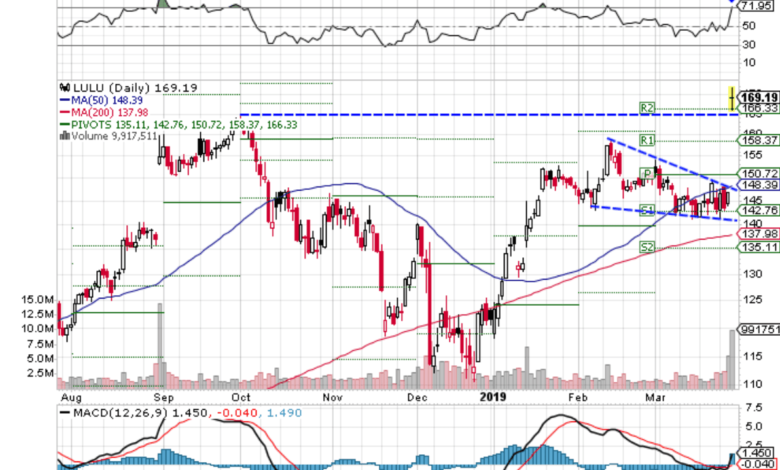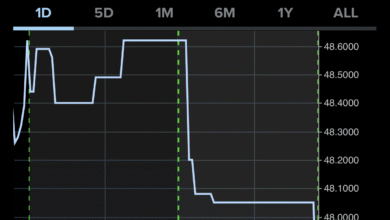Lululemon Stock Performance: Earnings Guidance Misses Mark

Lululemon stock performance recently captured the attention of investors as shares plummeted over 11% following a disappointing earnings guidance for 2025. The athleisure retail giant projected first-quarter earnings significantly below analysts’ expectations, with estimates ranging between $2.53 and $2.58 per share, compared to the anticipated $2.72. Additionally, their revenue forecast of $2.335 billion to $2.355 billion further contributed to investor concerns, as it fell short of the consensus estimate of $2.39 billion. Despite these setbacks, Lululemon’s fourth-quarter results managed to surpass both sales and profit expectations. Investors are now keenly focused on how Lululemon’s future performance will be influenced by broader market conditions and competitor developments, including news around U.S. Steel investment and other industry-specific earnings reports like Braze’s.
The recent volatility in Lululemon stock highlights the challenges faced by the athleisure market and its potential impact on the company’s financial outlook. As the brand navigates consumer sentiment and industry trends, analysts are closely monitoring its earnings guidance, particularly in light of the disappointing revenue forecasts which have stirred investor uncertainty. The decline in share value is set against a backdrop of varying performance across sectors; for instance, while Lululemon struggles, companies like Braze are enjoying robust earnings reports. As discussions around competitive investments, such as those involving U.S. Steel, evolve, the landscape may shift once again, affecting investor confidence in Lululemon and its peers. With multiple external factors at play, including economic conditions and consumer behavior shifts, Lululemon’s path forward remains a critical focus for investors.
Lululemon Stock Performance: Analyzing Recent Trends
Lululemon Athletica recently experienced a notable decline in its stock performance, plummeting over 11% following the announcement of their 2025 earnings guidance. This drop was primarily driven by forecasts that fell short of analysts’ expectations, with first-quarter earnings projected between $2.53 and $2.58 per share, while the consensus anticipated earnings of $2.72. Such a discrepancy highlights the market’s sensitivity to earnings guidance, emphasizing that investor confidence can quickly wane in the face of weaker-than-expected financial projections.
Despite the dip in stock performance, it is important to note that Lululemon’s fourth-quarter results actually exceeded expectations, showcasing strong sales and profit figures. This contradiction raises questions about the company’s long-term growth potential and the factors influencing investor sentiment. With a predicted revenue of $2.335 billion to $2.355 billion for the first quarter, which also falls short of the expected $2.39 billion, Lululemon must navigate increasing consumer uncertainty while leveraging its brand’s strength in the competitive athleisure market.
Understanding Earnings Guidance and Market Reactions
Earnings guidance plays a critical role in shaping how investors perceive a company’s future prospects. In the case of Lululemon, the weaker-than-anticipated guidance led to a sell-off by investors, reflecting a broader concern about economic conditions and consumer behavior. Such reactions are not isolated to Lululemon; they echo similar patterns seen with Oxford Industries, whose revenue forecasts for the year also fell short, prompting a 12% decline in shares. This starkly underscores the pivotal role of earnings guidance in influencing stock prices across sectors.
Investors are increasingly vigilant about earnings forecasts, especially in a climate of fluctuating consumer sentiment and inflation pressures. Comparatively, while Lululemon struggles with its projections, it’s critical to recognize how other companies like U.S. Steel are managing investments to boost confidence in their stocks. As Nippon Steel considers a significant investment in U.S. Steel, it highlights a contrast in market dynamics, showing that while some are struggling, others are strategically positioning themselves for growth and stability.
Market Reactions to Corporate Developments: A Case Study
The stock market often reacts sharply to corporate announcements and developments, as seen with Bausch + Lomb’s recall of certain eye lenses, which led to a more than 4% drop in their shares. This exemplifies how operational challenges and product safety issues can significantly impact investor trust. In a similar vein, Braze’s stock experienced a surge of about 9% following the release of a strong earnings report, showing how positive financial news can buffer against the market’s volatility.
Moreover, the industries these companies operate in play a crucial role in how market sentiments are shaped. Companies like Braze, providing innovative customer engagement platforms, are benefitting amidst a tech-driven market where user experience is paramount. In contrast, traditional industries like retail and manufacturing are grappling with challenges posed by shifting consumer preferences and operational risks, demonstrating the diverse factors at play in stock market performance.
Investment Strategies Amidst Market Fluctuations
As companies like Lululemon and Oxford Industries navigate challenging market landscapes, investors are reassessing their strategies in light of recent guidance and earnings reports. With Lululemon’s future performance now in question, it’s vital for investors to consider diversification and the potential impact of macroeconomic trends. For instance, stocks in technology and growth sectors, such as Braze, seem resilient, indicating a shift towards more innovative and adaptable companies.
Investors should also pay attention to significant investments in traditional sectors, such as U.S. Steel’s potential partnership with Nippon Steel, which highlights the ongoing interest in strategic mergers and acquisitions to bolster competitiveness. Adaptive investment strategies that balance growth stocks with stable investments could be essential in this current economic climate, especially as uncertainty looms over earnings reports and market predictions.
Consumer Behavior and Its Impact on Corporate Performance
Understanding consumer behavior is crucial for companies like Lululemon and Oxford Industries, especially in light of growing consumer uncertainty. The recent guidance from Oxford, projecting revenues between $1.49 billion and $1.53 billion for the year, reflects a cautious outlook as management cites shifting consumer sentiments. Similarly, Lululemon’s forecast highlights how external factors such as economic instability can influence purchasing decisions in the athleisure market.
The broader retail landscape is adjusting to evolving consumer needs, necessitating that brands remain agile and responsive. As companies respond to these trends, innovation and customer engagement become essential. For example, Braze’s success in executing a robust customer engagement strategy reflects the importance of connecting with consumers on various channels—an approach that Lululemon must consider to reclaim confidence and project positive growth moving forward.
The Importance of Strategic Partnerships in Growth
Strategic partnerships can serve as a lifeline for companies navigating market challenges, as demonstrated by U.S. Steel’s potential collaboration with Nippon Steel. Such alliances enable companies to secure necessary investments, increase market reach, and expand operational capabilities. By aligning with industry leaders, companies can enhance their credibility, which is essential in retaining investor confidence, especially when facing downturns in stock performance or negative news.
For Lululemon, exploring strategic partnerships, whether in supply chain, marketing, or product development, could bolster its position in the saturated athleisure market. As consumer preferences evolve, aligning with complementary brands or creating joint ventures may provide the fresh appeal needed to attract shoppers and mitigate the effects of slower earnings guidance. The ability to leverage shared resources and expertise can make a significant difference in a company’s recovery and growth trajectory.
The Role of Financial Analysts in Shaping Market Sentiment
Financial analysts play a pivotal role in shaping market sentiment and investor perceptions. The downgrade of Bausch + Lomb by Wells Fargo to equal weight after its lens recall underscores the significance of analyst reviews in stock performance. Analysts’ recommendations can drive trading behavior, catalyzing movements in stock prices through upgraded or downgraded assessments based on corporate developments.
For companies facing challenges, like Lululemon and Oxford Industries, analysts’ guidance could either exacerbate negative trends or help stabilize fluctuating stock prices. Engaging proactively with analysts and providing transparent updates on business performance can contribute to restoring investor faith. Essentially, fostering a dialogue with the investment community is crucial for companies as they manage both their public image and financial health.
Exploring Market Volatility and Investor Psychology
Market volatility often influences investor psychology, leading to swift reactions based on earnings reports and corporate happenings. In the case of Lululemon, the rapid drop in stock price following their weak earnings guidance illustrates how investor sentiment can shift dramatically. Understanding the psychology behind these decisions allows companies to better prepare and potentially mitigate negative fallout from disappointing projections.
The complexities of investor behavior also affect how companies strategize their communications during critical earnings seasons. Firms like Braze, which recently saw a positive earnings reaction, highlight how effective messaging around financial performance can harness investor enthusiasm. By being transparent and addressing market concerns proactively, companies can create a more stable investment atmosphere, essential for navigating the uncertainties present in today’s market.
The Intersection of Innovation and Market Demand
As companies adjust to market conditions, innovation remains essential to meet evolving consumer expectations. Lululemon, while currently facing challenges, can leverage its brand strength by emphasizing product innovation and expanding its range in response to consumer trends. Engaging a community-driven approach in product development could facilitate generating renewed interest and sales, thus driving revenue back towards projections.
Comparatively, Braze illustrates how embracing innovation can yield positive outcomes, with its focus on enhancing customer engagement resulting in stronger financial performance. This case study serves as a reminder for other brands that maintaining a pulse on market demand and consumer needs is critical in retaining relevance and competitive edge. Ultimately, the ability to innovate effectively in tandem with market trends can significantly influence both immediate performance and long-term stock stability.
Frequently Asked Questions
What is the current outlook for Lululemon stock performance after the latest earnings guidance?
After Lululemon’s recent earnings guidance, the stock performance has dipped over 11% due to weaker-than-expected projections for 2025. Analysts anticipated earnings of $2.72 per share, while Lululemon expects a range of $2.53 to $2.58. Additionally, the forecasted revenue of $2.335 to $2.355 billion falls short of the consensus of $2.39 billion, reflecting market concerns about future growth.
How did Lululemon’s fourth-quarter results affect its stock performance?
Lululemon’s fourth-quarter results positively impacted its stock performance prior to the latest guidance insights. The quarter surpassed both sales and profit expectations despite the recent guidance causing a decline. Investors remain cautious, balancing the positive quarterly results with the concerns raised by the lowered projections.
What factors contributed to the decline in Lululemon stock performance recently?
Lululemon’s stock performance has recently declined primarily due to its 2025 earnings guidance being below market expectations. The announcement of first-quarter earnings projections that significantly undercut analyst forecasts has led investors to reassess the company’s growth trajectory, resulting in a stock drop of over 11%.
Is Lululemon’s earnings guidance a sign of long-term challenges impacting stock performance?
Yes, Lululemon’s earnings guidance suggests potential long-term challenges that could affect its stock performance. The lower-than-anticipated earnings and revenue forecasts indicate difficulties in maintaining growth, particularly in a climate of increasing consumer uncertainty, possibly reflecting broader market conditions.
How does Lululemon’s stock performance compare to other companies following earnings reports?
Following recent earnings reports, Lululemon’s stock performance contrasts sharply with companies such as Braze, which saw an increase of about 9%. While Lululemon’s shares fell due to disappointing guidance, Braze’s performance reflects investor confidence in exceeding earnings expectations amid varying market conditions.
| Company | Stock Movement | Key Highlights |
|---|---|---|
| Lululemon Athletica | -11% | Provided weaker than anticipated 2025 guidance; Q1 earnings projected lower than analyst expectations. |
| U.S. Steel | +5% | Investments from Nippon Steel to facilitate merger approval with U.S. government. |
| Bausch + Lomb | -4% | Voluntary recall of eye lenses; Wells Fargo downgrades rating. |
| Braze | +9% | Exceeded Q4 earnings expectations; strong revenue performance. |
| Tanger | +0.6% | Goldman Sachs upgraded rating to buy. |
| Oxford Industries | -12% | Full-year guidance below consensus; consumer uncertainty cited. |
| Rocket Lab | +8.7% | Inclusion in U.S. Space Force launch provider pool. |
| AppLovin | +9% | Stock rebound after previous decline, addressing allegations. |
Summary
Lululemon stock performance took a significant hit, dropping over 11% due to weaker-than-expected guidance for 2025. Despite strong fourth-quarter results that exceeded sales and profit forecasts, the company’s projections for the first quarter disappointed analysts, particularly in anticipated earnings and revenue. This downturn highlights the volatility and investor sensitivity surrounding retail benchmark stocks, especially amidst changing consumer dynamics.




